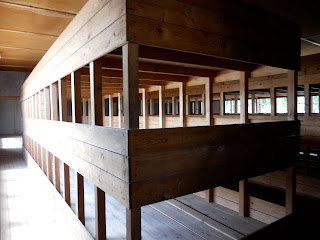When people hear about Munich, most think of an exciting city with plenty of beer drinking, sight seeing and sausage. That was my first impression before I went as well. I thought it would be very exciting to visit the Houfbrau house and see the beer gardens. In fact, that was how I spent nearly all the first day, and I was not disappointed. The second day, however, was completely different. My group and I decided to tour Dachau and learn about the region’s checkered past.
At 11:00am that morning, we had just finished breakfast and were heading to Mariaplatz, the main square of Munich. It was there we were supposed to meet our tour group. On the way, however, we were enticed by the street meat, and stopped to eat some sausage. We ended being a few minutes late to the tour, but I didn’t mind, because that was the best meal I had all weekend.
When reached the meeting point, we were ushered by our guide Katie onto the metro to go to Dachau. After a short metro and bus ride, we emerged into a completely different environment. The city and people were gone, replaced by woods and a sleepy small town. The cars and tours were also gone, creating a very quiet atmosphere. It all seemed very surreal. How could such an atrocity happen in such a tranquil place? Had I not been led there, I would have thought I was lost. The group leaders knew where we were going however, and led us down a gravel path with trees and a few buildings. We eventually came to a clearing with a moat and gate house with the words, “Arbeit Macht Frei” meaning, “Work Makes You Free.” Beyond the gates was a huge gravel square almost a kilometer across. At this point I immediately knew where I was.
The first thing Katie talked about was the mental torture the Nazis inflicted on the inmates. Even the doors into camp were a form. Inmates saw them and thought that if they worked hard, they might be set free. The grim reality however, was that the harder they worked, the more likely they were to die. Other forms included having pockets in their pants even though it was illegal to put their hands in them and having shampoo in the general store even though all the prisoners had shaved heads.
Walking across the spare was an experience. It was very bewildering thinking I did not want to be there for more than an hour or so, but then realizing that the prisoners had to stay there most of their lives (if they were lucky). Many other people simply died due to lack of food, clothing, or disease. Towards the end of the camps existence, the capacity was well over 20 times what it was when it was first opened, food was at the lowest quality, and disease was highest. Exacerbating the situation was that there was no escape for prisoners. They had to constantly deal with the death around them. If someone were to die in the night, they would have to physically drag them out to Role Call Square and get them counted.
Individuals in the camp were divided up by religion, ethnicity, and race. Each person had to wear a certain color triangle in a certain direction. If the triangle was pointed up, it meant they were from outside Germany. If it was pointed down, they were foreigners. Red was for political prisoners, blue for Jews, brown for Russians, etc. Prisoners in the camp, while all were treated badly, received relatively better or worse treatment based on the color. Jews had the worst experience, while Jehovah’s Witnesses had it the best. I thought this was interesting because even though they were all sent to die, the Germans still divided them up.
The end of the war was still not an end to the suffering. Individuals had to return to whatever homes and family they had left, if any at all. Even if they were lucky enough to have family alive, they still had to deal with all the suffering they had been through and live in a society that would view them differently.
At the end of the war, Most of the concentration camps and all of the extermination camps were located in Eastern Europe. This was because there were higher concentrations of ‘undesirables’ there. One small benefit, however, was that the coal quarries in Bulgaria were liberated early, which stopped the Germans from killing and burning more humans beings in the ovens.
I would definitely recommend a trip to Dachau to any person traveling to Munich. If you are limited on time, however, maybe forgo the tour part and just travel their on your own. I feel that it gave me a better understanding of the city, and how its residents deal with the past. It was not just a huge party, instead I had a glimpse at what Munich is actually like.























